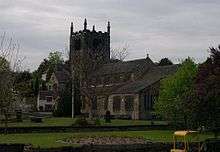Church of All Saints, Bingley
| Church of All Saints, Bingley | |
|---|---|
|
Church of All Saints, Bingley | |
| Country | England |
| Denomination | Church of England |
| Churchmanship | Central Churchmanship |
| Website | http://www.allsaintsbingley.org.uk/ |
| Architecture | |
| Status | Parish Church |
| Functional status | Active |
| Heritage designation | Grade II* |
| Designated | 9 August 1966 |
| Administration | |
| Parish | All Saints Bingley |
| Deanery | Airedale |
| Archdeaconry | Bradford |
| Diocese | Leeds |
All Saints Church is the Anglican parish church in the town of Bingley, West Yorkshire, England.
The history of the church probably dates back to pre-Norman times. It is thought that there might have been a wooden church on this location for many years prior to the Norman conquest, although no records exist. The first records of the church indicate it was rebuilt some time after 1066 by the Lord of the Manor, William Paganel, who gave it, with other possessions of his, to Drax Priory in the time of Archbishop Thurstan (1119–1140).[1]
This building was probably rebuilt many times over the centuries, culminating in the present structure, which was begun during the reign of Henry VIII (1491–1547).[2] The choir was erected in 1518,[3] when the church was dedicated to All Saints, having previously been dedicated to Saint Lawrence.[4] The current tower was heightened and a new belfry added in 1739.[5]
The church received a new clock in 1856 and was renovated in 1870 - 1871 when the Ferrand Chapel became the vestry and some of the pews that were tied to the local Manor Houses were stripped out.[6]
The church has a stained-glass window crafted by William Morris and Edward Burne-Jones.[7] There is a peal of bells, for many years six in number, with a further two added in 1873. The church was Grade II* listed in 1966.[8]
The parish includes the churches of St. Aidan, Crossflatts and St. Lawrence, Eldwick and is part of the Bingley Group Ministry which includes Holy Trinity Church and St Wilfreds in Gilstead.[9] The benefice used to lie within the Diocese of Bradford, but since 20 April 2014 it is now in the Diocese of Leeds.[10]
References
- ↑ Horsfall Turner, JP (1897). Ancient Bingley: or, Bingley, its history and scenery. Horsfall Turner. Retrieved 8 January 2016.
- ↑ "BingleyConservationAreaAssessment.pdf" (PDF). March 2004. p. 12. Retrieved 8 January 2016.
- ↑ "Bingley All Saints' Church". www.archaeology.wyjs.org.uk. Retrieved 8 January 2016.
- ↑ Dodd, E E (1958). Bingley - A Yorkshire Town through nine centuries. Guiseley: MTD Rigg. p. 24. Retrieved 20 February 2016.
- ↑ Ryder, Peter; Gwilliam, Paul (1993). Medieval Churches of West Yorkshire. Wakefield: West Yorkshire Archaeology Services. p. 87. ISBN 1-870453-17-4. Retrieved 27 February 2016.
- ↑ Dodd, E E (1958). Bingley - A Yorkshire Town through nine centuries. Guiseley: MTD Rigg. p. 148. Retrieved 20 February 2016.
- ↑ "All Saints Bingley The Burne-Jones Window". www.allsaintsbingley.org.uk. Retrieved 8 January 2016.
- ↑ "Church of All Saints - Bingley - Bradford - England". www.britishlistedbuildings.co.uk. Retrieved 8 January 2016.
- ↑ "Holy Trinity and St Wilfrid's Bingley". www.holytrinityandstwilfrid.org.uk. Retrieved 8 January 2016.
- ↑ "First new diocese since 1929 created in Yorkshire". BBC News. Retrieved 8 January 2016.
External links
Coordinates: 53°51′05″N 1°50′29″W / 53.8514°N 1.8413°W
